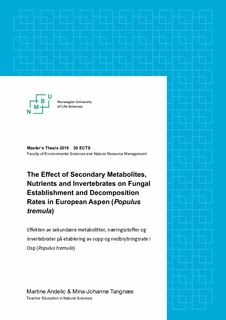| dc.contributor.advisor | Birkemoe, Tone | |
| dc.contributor.advisor | Sverdrup-Thygeson, Anne | |
| dc.contributor.advisor | Jacobsen, Rannveig M. | |
| dc.contributor.advisor | Nybakken, Line | |
| dc.contributor.author | Tangnæs, Mina-Johanne | |
| dc.contributor.author | Andelic, Martine | |
| dc.coverage.spatial | Norway | nb_NO |
| dc.date.accessioned | 2019-07-17T10:32:22Z | |
| dc.date.available | 2019-07-17T10:32:22Z | |
| dc.date.issued | 2019 | |
| dc.identifier.uri | http://hdl.handle.net/11250/2605638 | |
| dc.description.abstract | Fungal decomposer communities play an essential role in nutrient cycling and are one of the main drivers of decomposition. Although fungal community composition has been seen to influence the rate of wood decay, little is known about the influence of invertebrates and secondary metabolites on the activity and composition of fungal decomposers. Studies have found that the exclusion of invertebrates from newly dead trees decrease decomposition rates in deadwood. Still, studies investigating if this is persistent through time are lacking. Therefore, the aim of this study was to investigate the influence of secondary metabolites, nutrients and invertebrates on fungal community composition and decomposition rates in Populus tremula.
Considering that our study was a follow-up, we analyzed wood and bark samples taken at the onset of the previous study to investigate the relationship between initial nutrients, secondary metabolites and fungal communities. This was then linked to fungal OTU (operational taxonomic unit) data from the previous study. To investigate if the effect of initial invertebrate exclusion on wood decomposition was maintained through time, we resampled 120 logs distributed between 30 sites for new density measurements. In addition, the number of polypore fruit bodies was recorded on all 120 logs to see if the number of polypore fruit bodies could reflect the degree of wood decay in logs.
We found that initial secondary metabolites and nutrients in individual trees significantly explained some variation in fungal community composition. Wood and bark chemistry also varied noticeably between individual trees of P. tremula, suggesting that individual trees can have divergent effects on decomposer communities. Although the initial invertebrate exclusion did not significantly affect wood decomposition five years after tree death, we still observed a trend in wood density similar to that of the previous study. We found that logs with many polypore fruit bodies had a significantly lower wood density than logs with none. This suggests that the presence of many polypore fruit bodies might indicate a greater density loss.
This study, along with the previous experimental study, strongly suggests that invertebrate exclusion along with initial wood and bark chemistry in P. tremula indirectly affect decomposition of dead wood through directly affecting establishment of fungal decomposer communities. Still, long term studies are needed to further understand the effect of invertebrates and initial wood and bark chemistry on fungi and wood decay. | nb_NO |
| dc.language.iso | eng | nb_NO |
| dc.publisher | Norwegian University of Life Sciences, Ås | nb_NO |
| dc.rights | Attribution-NonCommercial-NoDerivatives 4.0 Internasjonal | * |
| dc.rights.uri | http://creativecommons.org/licenses/by-nc-nd/4.0/deed.no | * |
| dc.title | The effect of secondary metabolites, nutrients and invertebrates on fungal establishment and decomposition rates in European Aspen (Populus tremula) | nb_NO |
| dc.title.alternative | Effekten av sekundære metabolitter, næringsstoffer og invertebrater på etablering av sopp og nedbrytningsrate I Osp (Populus tremula) | nb_NO |
| dc.type | Master thesis | nb_NO |
| dc.subject.nsi | VDP::Matematikk og Naturvitenskap: 400::Zoologiske og botaniske fag: 480::Plantefysiologi: 492 | nb_NO |
| dc.description.localcode | M-LUN | nb_NO |

